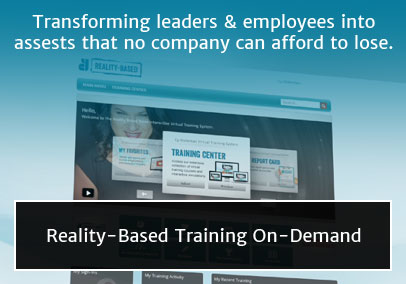My entry into Reality-Based Leadership started with the Open-Door Policy.
After several years as a family therapist, I got a promotion in my organization. For the first time, I would be leading a team, which got me a free ticket to the Human Resources boot camp for managers. Designed to prepare me for my new organizational role, it was basically a crash course in the current conventional wisdom around leadership.
One particularly juicy leadership gem, delivered to me by trainers with all the confidence in the world, was that a great leader always has an open door.
An open door? That was easy. Not only was I going to have an Open-Door Policy, I was going to ace it! I hustled down to the gift shop at the health center where I worked and bought a doorstop to make a visible and decorative point: I’d have the most outstanding Open Door in the organization.
The Open-Door Policy did exactly what it was supposed to do. Soon team members began popping their heads into my Open Door.
“Do you have a minute?” they asked.
“Sure, I have two!” I’d reply. “Come on in.”
It didn’t take long to realize that these people were liars. They’d ask for a minute or two, but then stayed planted in my office for an average of 45 minutes.
Now, if they had really needed me — to talk through a critical decision for serving the business or to help them develop or hone skills — the time investment would have had a satisfying pay off. But people weren’t coming to me for that.
People came in to tattle on others. They wanted to tell me stories they’d concocted about things that hadn’t even happened. Or they’d vent about circumstances that couldn’t be changed (what I call reality.) They’d use our time to spin fantasies about the future. Frequently, it was a combination. I spent the majority of these impromptu “Got a minute?” meetings listening to elaborate narratives that had almost no basis in reality.
The kicker? At the end of the meeting, they would say to me, with a straight face: “Please don’t do anything about this. I just wanted you to be aware.”
As I witnessed the economic effect of this Open-Door Policy in action, it made no sense to me. Where was the return on the investment I had made in that doorstop? Can you imagine what would happen if went to the CEO and said, “I plan to spend 10 hours a day in a series of 45-minute one-on-one meetings talking about stuff that doesn’t add one whit of value to the company. And I’m going to expense the door stop.” I’d be opening the door into the unemployment office.
The HR wisdom that had been drilled into me said an Open Door was the right thing to do. It was touted as a best practice that it would lead to happy, engaged employees. We had been instructed that we should allow employees to vent, because venting is “healthy.” (While I agree that venting can feel good, so does crack cocaine, and no one would call that healthy.)
During the time I was an Open-Door Policy devotee, I don’t recall team members ever tattling on themselves. They weren’t coming to me and saying, “You know, I am really having trouble aligning my actions and decision-making to the strategy of this business. I’d like to become more effective at serving our customers better. Can you help me develop my skills and work processes so I can meet company goals, add value to the team and better contribute to ROI?”
No one used my Open Door to directly ask for coaching on handling sticky issues in a more effective, productive and efficient way. In fact, they drove their BMWs (bitching, moaning and whining) through the Open Door and parked with their engines idling, wasting fuel and polluting the atmosphere. Then they demanded that I withhold the kind of direction and help that would help them get where we needed to go.
I realized pretty quickly that the Open Door was a portal for drama, fueling feelings of victimhood and contributing to low morale. Worse, it was costing the company a lot of money. We all had been hired for the value we could contribute to the important work we did, not for the wonderful, drama-filled stories we could concoct. I knew my time was better invested by helping people reflect, increase their self-awareness, and look at situations from a higher level of consciousness.
After this proverbial “Aha!” moment, I abandoned the Open-Door Policy. It was one of my first acts of Reality-Based Leadership. I didn’t shut the door on my team members, exactly, but I began changing the conversation when me they asked for a minute. Instead of passively listening or directing, I began asking questions:
“What is your part in this?”
“What do you know for sure?”
“What are your ideas for resolving this issue?”
“What are you doing to help?”
When they came to me with narratives about the problems they encountered, I gave them a mental process that forced them to deconstruct their “stories” and move into action. It shifted their thinking to a focus on the facts. And it asked them to outline proposed solutions or helpful actions that would positively impact the situation.
CONVENTIONAL WISDOM FAIL
The Open-Door Policy failure got me to thinking more about the conventional wisdom that had been dispensed in my leadership training. What if what we had been taught in HR’s leadership boot camps was all wrong? Based on the result we were getting; it certainly didn’t seem to be working.
I could see the damage being done when employees were what I came to label as “emotionally expensive.” These were the folks who spent their time arguing with reality instead of confronting it directly. They contributed opinions instead of action. They judged others instead of offering help. They saw themselves as victims of cruel circumstances instead of understanding that circumstances are the reality in which they must succeed.
One of the first mental processes I taught employees, adapted from my cognitive therapy background, was how to edit their stories and eliminate the emotional churn that muddied the waters and obscured reality. People began to learn productive ways to resolve their own issues. They began to figure out what the real issues were, and come up with productive options for tackling them. They stopped the BMW driving. It wasn’t long before our team began operating in a completely different way. While leaders in other departments were getting bogged down in constant firefighting, the teams I worked with were becoming independent, efficient and highly engaged.
That sparked even more introspection about the role of leaders. What if the role of leader is nothing like what we’ve traditionally assumed? What if a leader’s role isn’t to improve morale or motivate employees? What if a leader’s role isn’t to make sure all the employees are engaged and happy? What if these expectations set leaders up for failure?
After all, not a single budget I have ever seen or managed has a line item for Unnecessary Drama. But even my short experience with the Open-Door Policy had shown me Emotional Waste was costing the company big time.
What if a leader’s job is actually is to refuse to foster the daily theatrics at work, and to coach employees in ways that are grounded in reality? The best way to eliminate waste in the workplace is to improve processes and the best way to eliminate emotional waste from the workplace is to implement great mental processes. In fact, I have redefined the role of a leader to be one who eliminates emotional waste from the workplace by teaching and holding others accountable to great mental processes.
For more from Cy, follow her on Facebook, Twitter, LinkedIn and Instagram.



Kristi says:
This is a really good read. Makes you think. I am not in management, but this applies to all who want it to.
LaTivia Carr says:
This was very insightful and can be applied across any industry.
Suzanne Weller says:
A great article that resonates with me on so many levels as a people manager and leader. Thanks for capturing this so effectively and thoughtfully.
Annie says:
Reminds of the adage “Don’t bring a problem to my door without also bring some solutions”
Vanessa Lesperance says:
Interesting take. I love that you turned these into coaching conversations which is great…but it seems to me you still had an open door policy? The difference was how you took charge of those impromptu one-on-one sessions – and because of your effective questions, you did help to drive morale and engagement. Although you question if leaders are responsible for employee engagement, motivation and morale (which I strongly feel they are), it seems you acknowledge that you saw those results based on your leadership skills – implying that leaders DO influence and drive those results.
Cy Wakeman says:
Thanks for your comment, Vanessa! I relate this concept to when I am speaking on stage. I need to have excellent speaking skills, I need to be engaging, I need to have great content, I need to tell stories to relay concepts well. That said, some people will listen to my speech and be motivated. Others will not be. So what I am trying to say in this article that despite a leader’s skills, employees will still have to come to the table with their own motivation, working on their own mindset, deciding whether or not to be engaged. Engagement, happiness, motivation… those are inside jobs. We cannot change anyone else. We can only invite them to change.